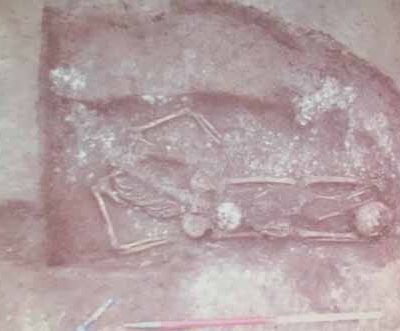

Cotswold Archaeology undertook an excavation ahead of a development by Linden Homes. They carried out geophysical surveys, which showed dense features. An evaluation trench revealed very little, but 19 worked flints were recovered including microliths, including a microdenticulate. There was probably a temporary camp in the Mesolithic.
The earliest features are Iron Age. There are two separate areas of the site =-the West and the North that contain postholes and pits. In the West of the site there are postholes but no patterning. They are deep at 1m x 35cm wide. Were they used as postholes for totems?
In the East of the site are possible granaries. There are small structures, not domestic, plus 11 large pits for storage that contained charred barley and emmer wheat. The pits were fired. Very little pottery, but two fragments had a zig-zag pattern comparable to Cunliffe’s Croft Ambrey pottery dated 5-4th Century BC.
Dates from the pits are 668-408 cal BC and 430 – 362 cal.BC late to early Iron Age start of the 5th Century BC. There was no enclosure at this time.
The Romano-British period has rectilinear enclosures and ditches. The first enclosure was a boundary for a settlement which could continue into the Northern field. There is 3-4th Century pottery. A cremation in the ditch is dated 47 – 63 cal.BC. There was a hearth on site which suggests smithing was carried on. There is also a curvilinear enclosure ditch which is difficult to interpret.
Data from the ‘Rural Settlement of Roman Britain Project’ was used to interpret the site. The Project data can be downloaded from the Archaeology Data Service (ADS) site as a Pdf. There are three categories, 1) Unenclosed farmstead; 2) enclosed farmstead and 3) complex farmsteads. From the late Iron Age onwards there is a rise in complex farmsteads and by the 1st Century AD there is an increase in production.
At Thornbury there are two cremations and thirteen burials and a total of sixty individuals. They are mainly adult males. The cremation was found in a ditch and contains a small amount of bone that had possibly been redeposited. Later inhumations are dated to 214 – 381 cal.AD and 82 – 228 cal.AD. They are later than the ditches and respect them.
There is much variation in how the dead were buried: 4/5 are supine face up (standard burial), one with hobnails; 9 are not typical and is a crouched female with hobnails (late Roman); 6 are prone face down and are clustered together (2 had nails in their mouths (compare Sea Mills and Hinkley Point)); 1 male was decapitated with his head at his feet and he may have had an obese form as his arms were spread widely. A corpse of a 4-5 year old child was placed over this adult’s legs.
Overall on the site burial is not standard at all and the question to be asked is why so many burials are odd ones. Future work needs to look at the field north of the site.

The decapitated burial from Thornbury.
